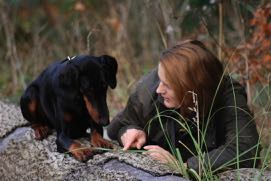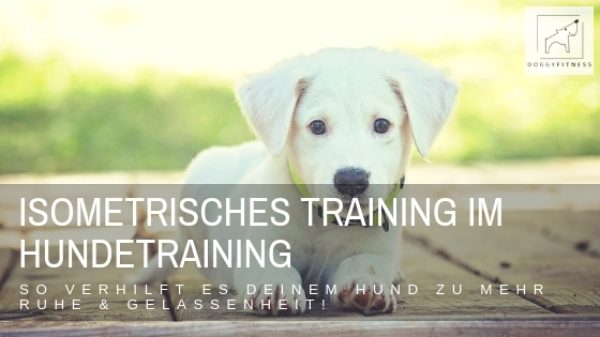If you’ve been following my blog for a while, you know that I’m a big fan of isometric exercises and always see the close interaction between body and mind in my movement training. All the more I am happy about the guest article by Ilka Hochstein, who highlights the effect and use of isometric exercises from a dog training perspective! Enjoy the article!
Isometric training in dog training
In November 2018, Martina wrote about the isometric exercises for muscle building and that these exercises are significantly underestimated. Today I present to you another benefit of these unappreciated exercises. Stressed dogs or easily excitable, nervous and anxious dogs benefit greatly from these exercises. Because you can incorporate it into training as conditioned relaxation.
Well trained these exercises can help in the long run that the dog becomes more calm and self-confident. To be able to relax, you have to let go. We train this with the isometric exercises.
What are isometric exercises? I
sometric training dog training
Placing the hand with light pressure causes a change in tension in the muscle in the dog. This promotes the perception of their own body and and strengthens the own body feeling.
Now, if the dog gets into an exciting situation during a walk, we can use the isometric exercises we learned earlier.
Through the voluntary contraction and relaxation of various muscle groups, the dog must direct its concentration to itself (away from the trigger), if the tension is now followed by a release, then a state of relaxation can be induced. The exercises bring the dog back to the “here and now” as he has to focus on himself. Now this does not mean that the dog immediately falls into a deep sleep after a very exciting situation, but there is the possibility that the dog quickly shuts down and becomes responsive again from its reactive action.
What is the benefit in dog training?
An excited dog is under physical and emotional tension, the dog owner can easily recognize this by the fact that the body movements become stiffer and the muscles firmer. The center of the body shifts, the dog’sweight now rests more on the front or hindquarters.
If the fight or flight system of the dog is activated it needs energy and the muscles are tensed, this is never followed by deep relaxation, then the residual tension remains in the body and becomes even greater at the next stress trigger in a stress cascade. Health problems can be the result, we can effectively interrupt this upward spiral.
Through specific training, the dog learns that after placing the hand on certain muscle groups, the relaxation of these muscles follows. This letting go can only happen when the dog comes back intobalance, because relaxation is the opposite of tension.
How it helps your dog
Through continuous training, we can help our dogs become more calm in everyday life and expect behavioral adjustment in the long run. Stress can thus be better compensated and certain mental and resulting physical complaints can be alleviated.
Have you ever noticed that your dog hugs you in exciting situations? This can be a sign for self-relaxation, because feel-good hormones, such as oxytocin, are also released.
We can do the training always and everywhere, because we don’t need anything but ourselves to do it. That the isometric exercises can only be a part of a dog training or behavior therapy is self-evident. They are not a panacea and are a part of the whole.
Have fun practicing
Ilka Hochstein

Information about myself:
Ilka Hochstein
I have been running a kennel and giving dog training for 7 years. In dog training our core element is degility training. There I work not only with dogs that have physical limitations, but more and more with the so-called “Hibbelhunden” or dogs that show behavioral problems. Click here for the website: Hunde Hof Hochstein
Also, in I am a dog health and nutritionist and support dog owners in food and health issues. Functional foods are important to me, because you are what you eat – this also applies to our four-legged friends. At the moment I am in training to become a phytotherapist for dogs in order to be able to promote the health of the dogs even more comprehensively. Isometric Training Dog Training Isometric Training Dog Training Isometric Training Dog Training Isometric Training Dog Training Isometric Training Dog Training Isometric Training Dog Training Isometric Training Dog Training Isometric Training Dog Training
Dieser Beitrag ist auch verfügbar auf:
Français (French)
Deutsch (German)
Español (Spanish)
















